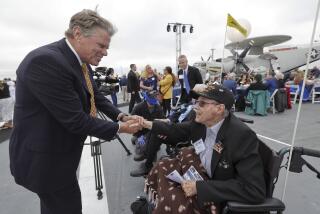Destination: Pennsylvania : Water Works : Seaport Museum has monopoly on artifacts
- Share via
PHILADELPHIA — The 34-year-old Philadelphia Maritime Museum has been transformed into Independence Seaport Museum on the waterfront at Penn’s Landing, just a five-minute walk east of Independence National Historical Park.
When it opened in July, the $15-million museum in the 19-year-old Port of History building became the flagship of Penn’s Landing.
Highlights include displays about Philadelphia’s importance as a seaport 90 miles from the Atlantic Ocean, plus large-scale ship models and other nautical artifacts, including two real mini-subs that look too small for humans to squeeze inside.
Another highlight is “Workshop on the Water,” where visitors can observe construction of small boats like those made and used in the Delaware River region.
Outside on the river, visitors can explore two well-known attractions that now are part of the museum: USS Olympia, a cruiser that led a sea victory over the Spanish fleet in 1898, and USS Becuna, a World War II submarine that saw action in the Pacific.
From the Delaware River, the squat museum building resembles an early 20th-century coastal defense battery, without the artillery.
It has integrated the collections of the former Maritime Museum--a traditional maritime museum filled with model ships in glass cases.
“There’s nothing wrong with that,” said Jane Allen, the museum’s curator since 1984, “but the approach we’ve taken here is more interesting, much more vibrant and exciting.”
The first floor of the new museum puts artifacts into historic or environmental settings, then enlivens them with oral histories, sound effects, videos, computers and other interactive displays.
“We’re trying to get away from a fine arts presentation, which is what we did in the old building,” Allen said.
The Philadelphia Maritime Museum “was a great museum for people who already knew something about maritime history and had an interest,” said Paul DeOrsay, assistant director, but did not do a good job attracting and educating people who didn’t have such an interest.
At the Seaport Museum, visitors learn what happened to immigrants arriving in Philadelphia and about its ship-building industry. Old bicycles are parked in different spots because that’s how workers got around shipyards.
Independence Seaport claims to be the only U.S. maritime museum that focuses on late 19th and 20th century urban industrial maritime history. More specifically, it claims to focus on the Delaware River, its bay and tributaries. That theme is best reflected in “Workshop on the Water” and the first-floor permanent exhibit, “Home Port: Philadelphia,” which focuses on immigration, industry, commerce, defense, ship-building and recreation, including fishing and hunting.
“Workshop on the Water” has become one of the most popular areas. Visitors watch craftsmen use traditional skills to build wooden boats like those made in the region in the 19th and early 20th centuries.
But the regional emphasis evaporates in “Divers of the Deep,” the second permanent exhibit on the first floor. Artifacts from sunken Spanish galleons don’t have anything to do with the region, for example, and the two mini-subs, named Star I and Guppy, weren’t made or used in the Philadelphia area.
The two ships outside also don’t have obvious ties to the region, though they have been landmark attractions on Philadelphia’s waterfront for many years.
“Not everything is specifically from our region,” Allen said. “Most maritime museums in the United States are regional in nature. But all maritime museums tend to be national and international in some regards. Ships, by their nature, are international.”
Olympia, launched in 1892 as one of the nation’s first steel warships, is the sole surviving vessel of the Spanish American War fleet. In 1921, after World War I, it brought the body of the Unknown Soldier to Arlington National Cemetery from France.
Becuna, commissioned in 1944, is a Guppy-class World War II submarine that sank many Japanese naval and merchant ships. It’s called one of only a few World War II submarines still on display in the United states.
The nonprofit museum has a maritime library, open to the public by appointment, and a 540-seat auditorium that is used for various programs throughout the year.
There’s also a discounted RiverPass that may encourage visitors to spend a full day along the river, adding a visit to the New Jersey State Aquarium in Camden, N.J., which just completed a $3.75-million renovation.
(BEGIN TEXT OF INFOBOX / INFOGRAPHIC)
GUIDEBOOK: Down by the River Side
Hours: Independence Seaport Museum, 10 a.m.-5 p.m. daily, closed Thanksgiving, Christmas and New Year’s Day.
Admission: Combined admission to the museum and two ships, Olympia and Becuna, is $7.50, $3.50 for children 5-12, $6 for seniors. Museum-only admission is $5, $2.50 for children, $4 for seniors. Discount rates are available for groups of 20 or more.
Discounted RiverPass tickets include the museum and its two ships, New Jersey State Aquarium in Camden and round-trip transportation across the Delaware River aboard the Riverbus Ferry. Through March 10, there is also a $1-off coupon for skating at the Blue Cross RiverRink, about half a block away. Cost is $15, $10 for children 3-11, $12 for seniors.
Tours: Guided tours can be arranged. They also are available for people with disabilities. For information: Independence Seaport Museum, Penn’s Landing at 211 S. Columbus Blvd. and Walnut Street, Philadelphia, PA 19106-1415; tel. (215) 925-5439.
--R.K.
More to Read
Sign up for The Wild
We’ll help you find the best places to hike, bike and run, as well as the perfect silent spots for meditation and yoga.
You may occasionally receive promotional content from the Los Angeles Times.






